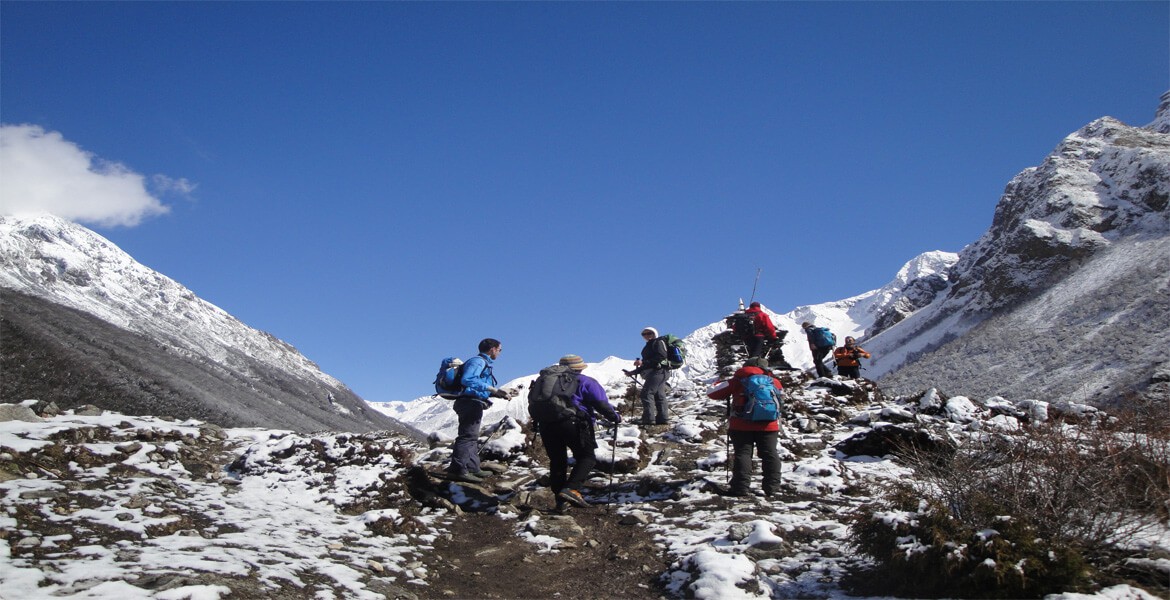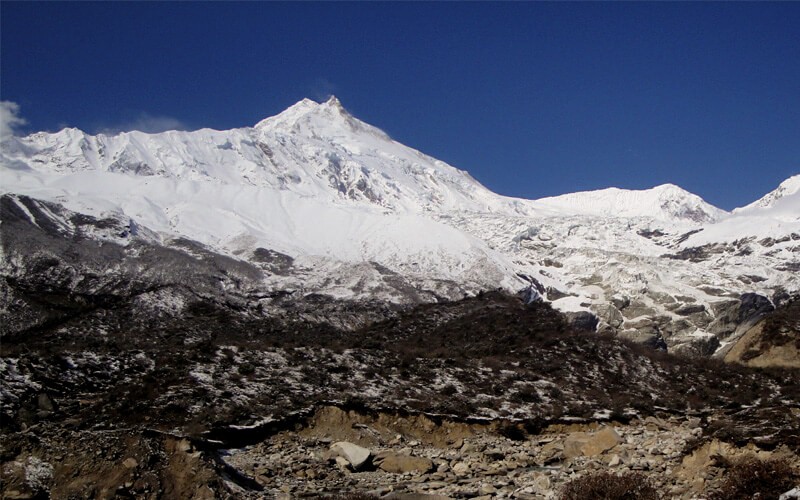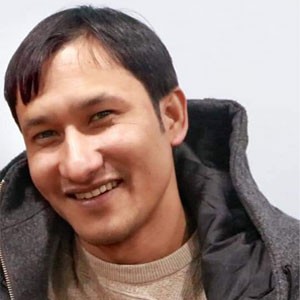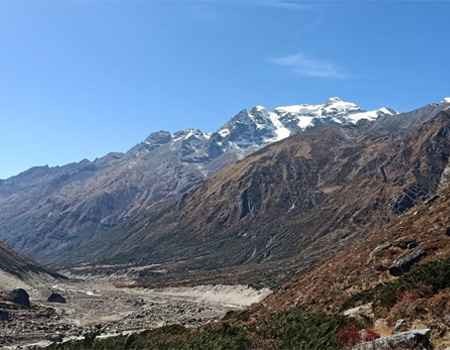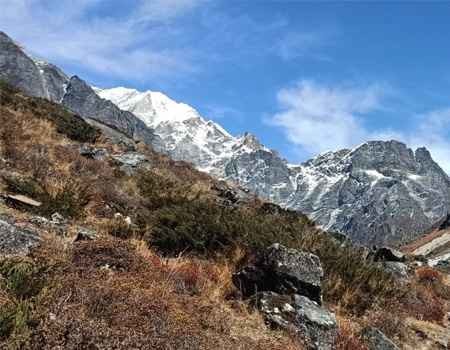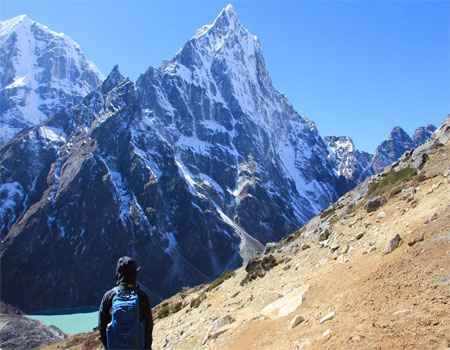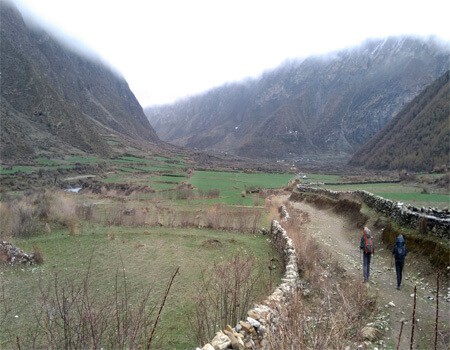Manaslu Base Camp Trek Highlights
- You can spot more than ten peaks of over 6,500 meters and a few of over 7,000 meters in the terrain.
- Observe the lifestyles of Nubri and Tsum, the two main ethnic groups in the Manasulu Region. Of both groups, Tsum still provides a glimpse of its ancient culture, art, and tradition.
- Spot monasteries, mani walls, and prayer wheels in the area
- Natural eye-catching scenery, high glacier lakes, fascinating flora, and fauna
- Trek to Manaslu Conservation Area
- Visit many Buddhist monuments and remote villages with magnificent mountain views.
- Hike to Manaslu Base Camp of the eight tallest mountains on the planet.
- An insight into Tibetan and Buddhist Culture
- A chill environment with peace and tranquillity in the less crowded.
- The spectacular scene of Himlung Himal (7,216m/23,345ft) and Mt. Manaslu (8153m/26,748ft)
Chances of Getting Altitude Sickness During the Trek
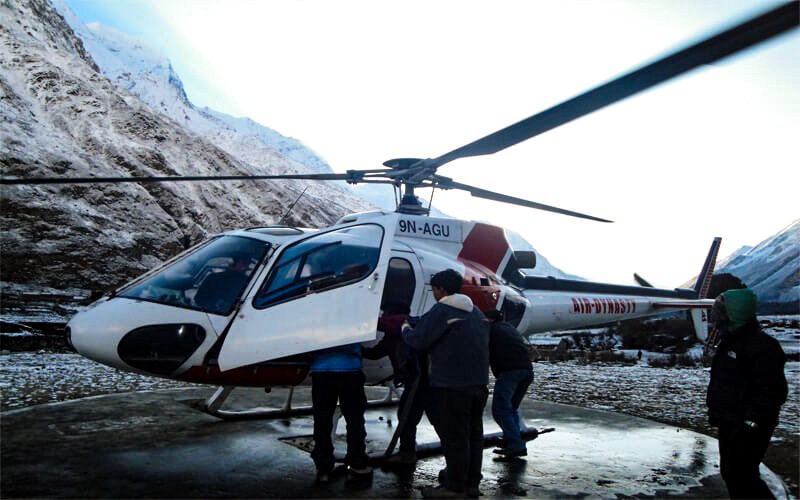
Mountain rescue
It is impossible to predict who will be affected by altitude sickness, which occurs at high altitudes between 3,000 and 5,120 meters above sea level. Since the Manaslu Trek's highest elevation is above 5,000 meters, you should give yourself enough time for acclimatization.
Do not rush. If you notice symptoms such as headaches, shortness of breath, fatigue, nausea, and loss of appetite, you must immediately descend to a lower elevation.
The weather condition in the Manaslu Base Camp
The weather at Manaslu Base Camp Trek depends on the month you're trekking. The temperature is pretty cold in January, though the sky becomes clear.
If you're hiking in the winter, it's freezing, but better preparation can make hiking possible. The weather remains freezing and icy during February, but the temperature slowly warms by the end of the month.
Some good lodges at Larkya Phedi and Bimtang remain closed during January and February. Since the beginning of spring-like April, the temperature has been beautiful, neither too cold nor too warm. Similarly, the lower altitude areas, especially in the Budhi Gandaki Region, remain warm during April.
July and August are two months for the monsoon. After the storm, upon arrival in September, you may find some potential rain. In November, the temperature starts to get colder. You can enjoy the chilly weather. High-altitude areas are pretty cold. December is moderately severe but reaches its extremity by the end of the month.
Related Articles:
Please get in touch with us for detailed information.
Manaslu Base Camp Trek Detailed Itinerary
Day 01: Arrival in Kathmandu [1350m.]
Our representatives will wait for you at Tribhuvan International Airport. You will then be transferred directly to your hotel room. Upon arrival, you will receive your welcome drinks. Refreshments will be served, and you will be introduced to the guides, who will further explain your trekking plans. Then, you can have a cozy rest or explore the capital's sights.
After breakfast, your guide will be at your hotel early in the morning, where he will further explain today's plan and possibilities. Since many sites must be visited in the capital, you can make an option with your guide.
Our morning journey begins with the Buddhist heritage at Syambhunath temple overlooking the valley from the top of the hill. After a magnificent view from the top, we move towards the famous Hindu temple of Pashupatinath, often referred to as the guardian god of the country. In the afternoon, we explore the historical sights of Kathmandu Durbar Square. Our journey ends at Boudhanath with spectacular views of the sunset.
Day 03: Drive from Kathmandu to Soti Khola [710m] 8 - 9 hours
Our adventurous Trekking journey begins today. The early morning drive from the hotel after breakfast starts your thrilling experience. We can spot amazing, magnificent views at Seti Khola. On our way to Soti Khola, we will be driving on the longest highway in the country, the Prithvi Highway. Moving forward, we come across the Trishuli River. It adds beauty to the trip with such a magnificent landscape view.
As we ascend, we cross the town of Arughat, which brings us very close to Soti Khola. We stay there overnight.
Day 04: Trek from Soti Khola to Machha Khola [869m]: 6 - 7 hours
We begin our Trek to Manaslu Base Camp Trek early in the morning. Ascending forward, we cross a bridge over Soti Khola. As we hike onward, we come across the Sal forest. You can hear the thundering roar of Budi Gandaki beneath. Ascending further on the Manaslu circuit trek, we soon reach villages Khursane and Lapubesi.
We walk through well-built stone tracks to reach Machha Khola, where we can witness magnificent views from the bride's viewpoint. We stay overnight at Machha Khola.
Day 05: Trek from Machha Khola to Jagat [1340m]: 6 - 7 Hrs
After an overnight stay at Machha Khola, we head towards the fabulous city of Jagat. As we ascend, we hike through the gorge up the river. Terrain remains winded up and down. Hilly landscapes you witness while crossing Tharo Khola and heading to Khorlbesi. From Khaleesi, we hike towards Tatopani. You can spot excellent hot, warm water at Tatopani.
The terrain at Manaslu Base Camp passes through the Budigandaki River and often crosses paths to reach Jagat, where we will spend the night.
Day 06: Trek from Jagat to Deng [1,860m]: 6 - 7 Hrs
Today, we trek to the hilly village of Deng, and stunning landscapes, dense sub-tropical forests, and small rivers brighten the trail. The trail climbs onto a rocky ridge heading to Salleri, continuing to Ghatta Khola crossing Sirdibas. Chasing the trail through somewhat leveled millet fields and pathways, we reach Ekle Bhatti and head along the Budhi Gandaki River before finally settling down at Deng. Overnight stay at Deng.
Day 07: Trek from Deng to Namrung [2,630m]: 6 - 7 Hrs
Our walk begins with crossing the Budhi Gandaki River. As we hike further, we enter the Manaslu Conservation Area, which is home to 33 species of mammals, including snow leopards, musk deer, and Himalayan Thar.
There are over 110 species of birds, three species of reptiles, and 1500-2000 species of flowering plants. Mesmerizing views of Serang Himal (7,161m) up and over the forests landing at the base of the hill leading to Namrung
Day 08: Trek from Namrung to Samagaon [3,520m]: 6-7 hours
Today, we are about to move towards an altitude of over 3000 m. The majestic Ganesh Himal(7,422m) and Himachali(7,863m) guide us on our trek. We ascend toward the quaint hamlet of Lihi, crossing several passes. The terrain winds down to Lho through prayer flags and stone cranes, continuing to Shayla. Today's walk ends as we reach Samagaon.
Day 09: Samagaon to Manaslu Base Camp and Return to Samagaun through Birendra Lake.
Today is the most important day of our trek. We will trek towards Manaslu Base and explore Amagaon. Our journey starts on a rocky trail past stone cranes and rocky ridges. Pilgrims often travel Samagaon paths, and sing songs. Samagaon crosses a 3000 m elevation of 3000 mtrmpa, which is blessed with views of Mt.Manasulu(8,163m) and Ngadi Chuli(7,871 m).7,871 mtr
Gompa belongs to the older generation of Buddhist artifacts. Since we are moving upward in our exploration, we may not find any tea houses further.
It's essential to carry lunch. After exploring upward, we descend to Samagaon again. As we descend, we pass Birendra Lake.
Day 10: Trek from Samagaon to Samdo [3860m]: 4 hours
The easy trail of the Manaslu Circuit Trek is this: We walk our way to Samdo today. Our journey begins with a steep descent toward the thrashing Budhi Gandaki before approaching the valley. During the walk, you can spot stunning mountain vistas.
The trail dives deep into alpine forests before reaching Kermo Kharka. Walking forward, we detect familiar Budhi Gandaki, beyond which the rugged trail leads to Samdo. Overnight stay at Samdo.
Day 11: Trek from Samdo to Dharmasala/Larkya B. C. [4460m]: 4 hours
We have already crossed 3500mtr. Our destination for today is Dharamsala. It is also the house of the base camp for Larky La Pass. Our terrains lead us to say.
Samdo heads towards the Larkya Bazaar, a famous Tibetan trading place in ancient times.
Once again, our trail descends toward Budhi Gandaki, where we reach the majestic Larkye Glacier. The journey continues toward Salla Khola, where we finally reach Dharmasala for the night.
Day 12: Trek from Dharmasala to Larkya la [5160m] - Bhimthang [3720m]: 8 - 9 hours
Early in the morning, we cross the Larkya La Pass (5160m). Larkya La pass is the highest altitude of our trek. Today we walked for long hours, dazzling sporting views of the world's largest Himalayas. Our trekking journey begins with a steep ascent toward the northern end of the Larkya Glacier.
The trail becomes steeper as the altitude rises before finally reaching Larkya La Pass at 5,160m. The view of Mt. Manaslu (8,163m), Samdo (6,335m), Ngadi Chuli (7,871m), and countless peaks stretching over 6,500 m is magnificent. We descend to Bhimthang for the night.
Day 13: Trek from Bimthang to Tilije [2300m]: 5 - 6 hours
Our long way back home begins today. After having our morning breakfast, we continue our descent from Bimthang toward Tilije. Once again, we descend to Budhi Gandaki towards Sangure Kharka, beyond which Kharka waits. Ascending further, we reach terraced farmlands and towards Gho, beyond which lies Tilije. Overnight stay at Tilije.
Day 14: Trek from Tilije to Chyamche [1430m]: 6 hours
Today, we head towards Chyamche, which falls under the Annapurna Conservation Area. The trail winds up towards the stony ridges adorned by the Mani stones and seas of prayer flags and towards Thonje. Taking mental notes in awe of the local way of life, we continue our journey to Dharapani. The trail here winds towards the Marshyangdi River before reaching Tal, where a steep descent takes us to Chyamche. Overnight stay at Chyamche.
Today, we walk towards chance. We are close to ending our Trekking journey, so we do not rush during our walk. Chyamche lies under the Annapurna Conversation area, and we can spot the prayer flags waving in the wind of three. We will reach Dharapni in a few hours. The trail leads towards the Marshyangdi River before reaching Tal Beyond. The trail steeply descends and takes us to Chyamche.
Day 15: Trek from Chyamche to Bhulbhule [840m]: 6 hours
Today is the final day of the Manaslu Circuit Trek. We descend downward to Bhulbhule today. Our walk begins along the banks of raging Marsyangdi via the lush green forest. The forest is filled with oak, juniper, and sal trees. We can witness magnificent landscapes as we head toward Bahundada. We look back, we realize we have left the valley behind our footsteps. We stay overnight at Bhulbhule.
Day 16: Drive back to Kathmandu. Farewell dinner
On the final day of the Manaslu Circuit Trekking, we head back to Kathmandu from Bhulbhule, crossing the hustling and bustling town of Besisahar on our way. The journey begins on the tight bends of Prithvi Highway, surrounded by pleasant landscapes before, for the final time, the Trishuli River joins us. A sumptuous farewell dinner with Frolic Adventure awaits us as we return to our hotel. Overnight stay at a hotel in Kathmandu.
After breakfast, we drive toward Kathmandu Valley early in the morning. Crossing Bhulbhule town of Besisahar on our way. We again drive along the longest highway in the country. We reach our hotel after a drive. Today will be your last day after a long trek on that isolated trail. You can get fresh in your hotel room, we will be waiting for you since we have dinner together for the last time. You can shop in the evening too.
Day 17: Departure to the International Airport
Today is your final day, and ours, too. With all those beautiful memories in our hearts, we must bid you farewell. Goodbye. We hope to see you soon in Nepal. Since we are here to serve you, our staff will drive you through the airport safely. We pray for your safe flight. Once again, we shared beautiful memories.
Accommodation in Manaslu Base Camp Route
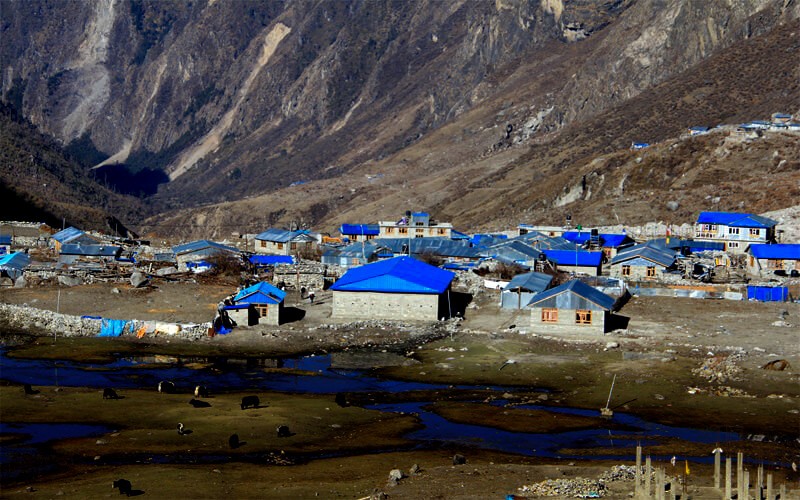
Accommodation type on the trek
Accommodation can be trekked with ease in the Manaslu region. It depends on your month of trek and how heavy the traffic may be on the trail. Toilets are mostly shared and can be outside of the teahouses. Heating is only available in the dining area. Foods are available in the teahouses. You will stop in the tea houses for lunch during the trek.
Internet and wifi factrekies in the Manaslu Region
You can find wifi facilities in the tea houses. If there are a lot of users, there may be a problem with high-speed Internet. The Internet is sometimes very much necessary to travel far from your home. If you want to communicate back home, an SAT phone is available in tea houses. The SAT phone may have extra money to call back home.
How Difficult is Manaslu Base Camp?
There are no such difficulties during the trek; anyone in good health can do it. The trek does not require individual physical fitness. Since we are going above, a 5000-meter trekker should be prepared before making the trek. The Manaslu trek is arduous on isolated trails; sometimes, trekkers cannot complete it due to incomplete preparation for their strength.
It would help to practice short Treks to check your stamina and capacity. Mental and physical preparation can also be invaluable.
Final words
Manaslu Base Camp Trek is one of the best classic treks. You will lose yourself in geographical charisma. Manaslu Base Camp Treks are rich with diverse culture, natural beauty, rudimentary settlements, and ancient Tibetan lifestyle. Are you ready for the most unforgettable moment of your life in the Manaslu region?
